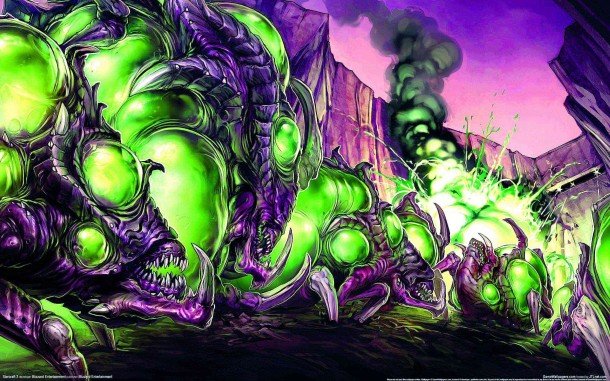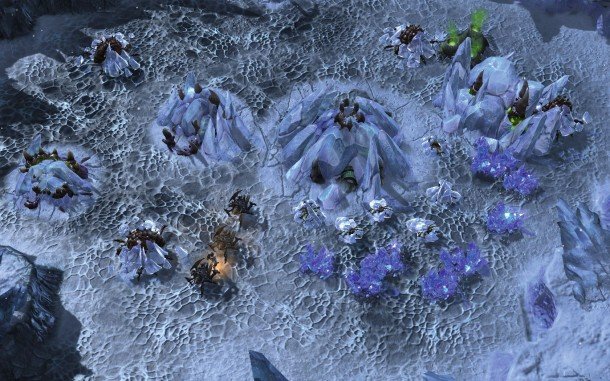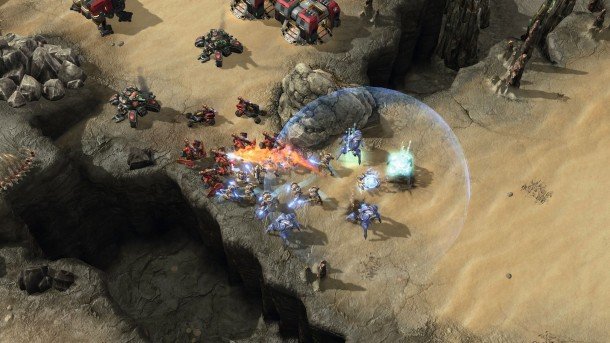Starcraft 2: Heart of the Swarm preview

Abathur is a gobbet of wet muscle that lives inside a hole. He's the keeper of Heart of the Swarm's tech tree, climbing out of his gooey home when the game's main character, Sarah Kerrigan, steps into his Evolution Pit. He speaks oddly, his yonic mouth and multiple skinny arms flapping as he discusses potential upgrades to the Zerg forces that Kerrigan commands.
"Blizzard wants to trim the vestigial tails and useless stumps from StarCraft II."
Abathur is obsessed with removing weaknesses and replacing them with strengths in the Zerg units he looks after. He is – ignoring the oozing skin, many sets of limbs and bug-like eyes – like Heart of the Swarm's developers, Blizzard. They both want to trim the vestigial tails and useless stumps from their subjects – in Blizzard's case, 2010's StarCraft II: Wings of Liberty – but they both realise that the entities at the centre of their experiments are already largely fit for purpose. Heart of the Swarm is shaped by evolutionary finetuning, not a back-to-drawing-board approach, and it looks a lot like StarCraft II.
Heart of the Swarm is the second StarCraft II expansion, but it's easily the size of a full game, with a 20-mission singleplayer campaign and a multiplayer revamp. Abathur lives in the singleplayer mode, alongside a cast of similarly monstrous friends. Iz'sha is a noseless Zerg 'woman', attached to the ceiling of the Leviathan ship that acts as Kerrigan's transport and home between missions. Kerrigan herself is joined on the 'bridge' – more of an open, pulsating sphincter – by a Zerg queen. As in StarCraft II: Wings of Liberty's campaign mode, these characters can be clicked on and spoken to, advancing the story and providing useful background information.

Kerrigan is the centrepiece of that story. She's an ex-Ghost: one of the human Terran race's super-psionic-soldiers. After being betrayed by Terran pantomime villain Emperor Arcturus Mengsk, she was infested by the Zerg and became the self-titled Queen of Blades. She's shed that moniker for Heart of the Swarm, losing her natty pair of bony wings in the process, but she's still very much boss of the Zerg. It's them you'll be playing as for the duration of the campaign, supported by Kerrigan herself.
"Kerrigan acts like one of Warcraft III's heroes, and she comes with unique abilities."
Kerrigan's presence on the battlefield as a super-unit is the most obvious difference between Wings of Liberty and Heart of the Swarm. She acts like one of Warcraft III's heroes, and she comes prepackaged with a set of unique abilities that can be turned against AI Terran and Protoss opposition. These abilities are set on a binary tech tree. Once Kerrigan's garnered enough experience to hit arbitrary levels – 5, 10, 15, and so on until level 60 – she can make a choice between two powers. For my first mission among her Zergy colleagues, I chose to give her a passive buff to healing and an area-of-effect attack that suspended select enemies in the air.
Zerg units have similarly binary choices when it comes to upgrades. Abathur presides over the Evolution Pit, in which he concocts betterments for existing Zerg units, presenting them in short, playable vignettes. The concepts for these upgrades are taken from local fauna, and the minimissions involve killing the poor creatures in the most horrendous fashion. Cheerfully bouncy birds and beetles that split on death allowed me to improve my explosive suicide bomber Banelings in one of two ways: either turning their green acid sacs purple and giving them the ability to leap up sheer cliff faces, or having them split into two smaller, less damaging creatures on detonation. I mourned the poor beetles and chose the latter option, deliberately tailoring my strategy in the next mission to maximise my Baneling count, purely to enjoy the glowing green carpet I was now able to send across the map.

Other units get the same treatment. Zerglings can either hop up cliffs or spawn faster from your home Hatchery, but unlike Kerrigan's power selection, your choices are locked in: pick the bouncy Banelings and you'll not be able to switch to the splitters. A third screen offers another layer of choice, giving unlocked units one of three passive abilities that can be altered between missions. Roaches, for example, can do more damage to 'light' class units, resist more pain at low health, or move around while burrowed.
The biggest gaming news, reviews and hardware deals
Keep up to date with the most important stories and the best deals, as picked by the PC Gamer team.
"Heart of the Swarm flavours its singleplayer missions with gimmicks."
I got to test these powers across three missions – the first two of which took place on the icy world of Kaldir. Kerrigan and her chitinous chums are on the planet to find a missing Zerg brood. Their queen's gone quiet, knocked out by a one-two punch of Protoss invaders and the planet's lethal cold. I came across remnants of the decimated group as I right-clicked Kerrigan and a handful of attendant Zerglings across the frigid ground: roaches frozen in place by flashfreezes, they came to life as I neared and joined my posse.
The flash-freezes continued as I came across first a readymade Zerg base and then the planet's Protoss forces. They'd kick in every few minutes, freezing the unprepared Protoss in place, but letting my evolved Zerg forces move around the map unmolested. Heart of the Swarm, like Wings of Liberty, flavours its singleplayer missions with gimmicks to save them from feeling like extended skirmish matches. The flash-freezes are a neat trick, allowing me to surgically pick off powerful Protoss units – glowing blue Archons and Roach-wrecking Immortals – while they were encased in ice. Defences down, I helped Kerrigan destroy a set of communication spires that ensured her presence on Kaldir was kept secret.

